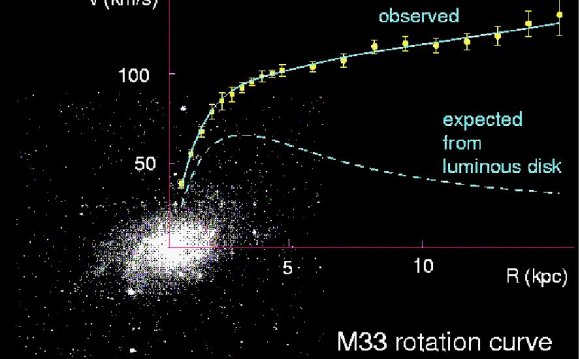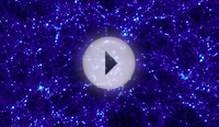
There are many theories and predictions among scientists to describe and explain the universe and its contents. Attempting to solve the dilemma of whether dark matter exists and, if so, what it consists of is of great importance to the scientific world. By definition dark matter emits no electromagnetic radiation but must have a large cumulative mass since its presence is inferred solely through its gravitational effects on visible (luminous) matter. It is now widely believed that dark matter does, indeed, exist and the standard model of cosmology anticipates that dark matter accounts for > 90% of all matter in the Universe. The overall matter-energy density of the Universe has been found to have large proportions of dark matter (23%) and dark energy (72%) (WMAP), which is consistent with the standard cosmological model.
Evidence
There are several pieces of observational evidence for dark matter in our Universe. Gravitational lensing (see figure below: Hubble Deep Field) and the unexpected rotational curves of spiral galaxies (see figure below: Rotational velocity curve) are among these observations that point to there being so-called "missing mass" throughout the Universe. Recent results from WMAP give us our most accurate value for the total mass in the Universe and how it is divided between different types of matter and energy.
The Hubble Deep Field.
Rotational velocity curve of the M33 galaxy.
These pieces of observational evidence lead to the idea of a dark matter halo approximated as a sphere surrounding the visible galaxy with a density distribution proportional to the radius squared, and contributing circa 90% of the galactic mass. The favoured dark matter candidate at present is the Weakly Interacting Massive Particle (WIMP). The WIMP halo is what all dark matter experiments are attempting to observe.
Directionality
WIMPs are expected to form a halo in and around the visible constituents of our Galaxy, the Milky Way. Since the Sun and, therefore, the Solar System is in motion around the centre of the Galaxy, it is expected that the Earth should experience a so-called 'WIMP wind' that is detectable as fluctuations in the magnitude and direction of a WIMP signal. All dark matter detectors with sufficient target mass, directional or otherwise, are capable of noticing an annual modulation due to the Earth's orbit around the Sun as the Sun orbits the galactic centre (see figure below: Annual modulation). Only directional dark matter detectors such as the DRIFT detector, however, have the ability to observe fluctuations in the direction of incoming WIMPs throughout a 24 hour period (see figure below: Daily fluctuation).
Illustration of annual modulation in a WIMP signal.
The solar system is ~ 8.5 kpc from the galactic centre and is travelling around it at ~ 220 km / s. The Earth's orbit around the Sun is inclined at 60 degrees to the galactic plane and the Earth's spin axis is 23.5 degrees from its orbital plane. This leads to a `WIMP wind' that means the WIMP flux observed by a static detector on Earth will not be isotropic, but will be peaked in the direction in which the Earth is travelling. This subsequently causes the nuclear recoil flux, due to WIMP-nucleon scattering, to be anisotropic also, although less so than the WIMP flux since scattering does not always happen with a full head-on contact between particles. A detector that can accurately reconstruct track information and produce directional data can observe the changes in signal flux over particular periods of time. For example, a laboratory located at a similar latitude to that at Boulby mine should observe a direction change in the signal from downward to Southward and back again during a sidereal day. The signal coordinates can then be transformed from the laboratory frame to galactic coordinates, which removes the effects of the Earth's rotation, and hence determine whether the signal is of galactic origin, which is expected of a WIMP signal, or not.
Illustration of daily fluctuations in a WIMP signal.
The nuclear recoils that must be observed for dark matter detection are of energies less than 100 keV. Dark matter experiments therefore need detectors with a good (low) energy threshold to be able to detect these recoils accurately. Directional dark matter detectors then also need to be able to demonstrate a correlation of these recoil signals and their anisotropy with what is expected due to the Earth's rotation. It is this recognition of patterns within the recoil flux and direction that allow directional detectors to identify any signal as galactic in origin, as it must be to be due to WIMP interactions. Directional detectors have the capability to then probe further into the structure and dynamics of the WIMP halo and distinguish between different halo models proposed from theory. This is a very powerful opportunity for directional dark matter detection to produce a definite and indisputable result.
INTERESTING VIDEO











